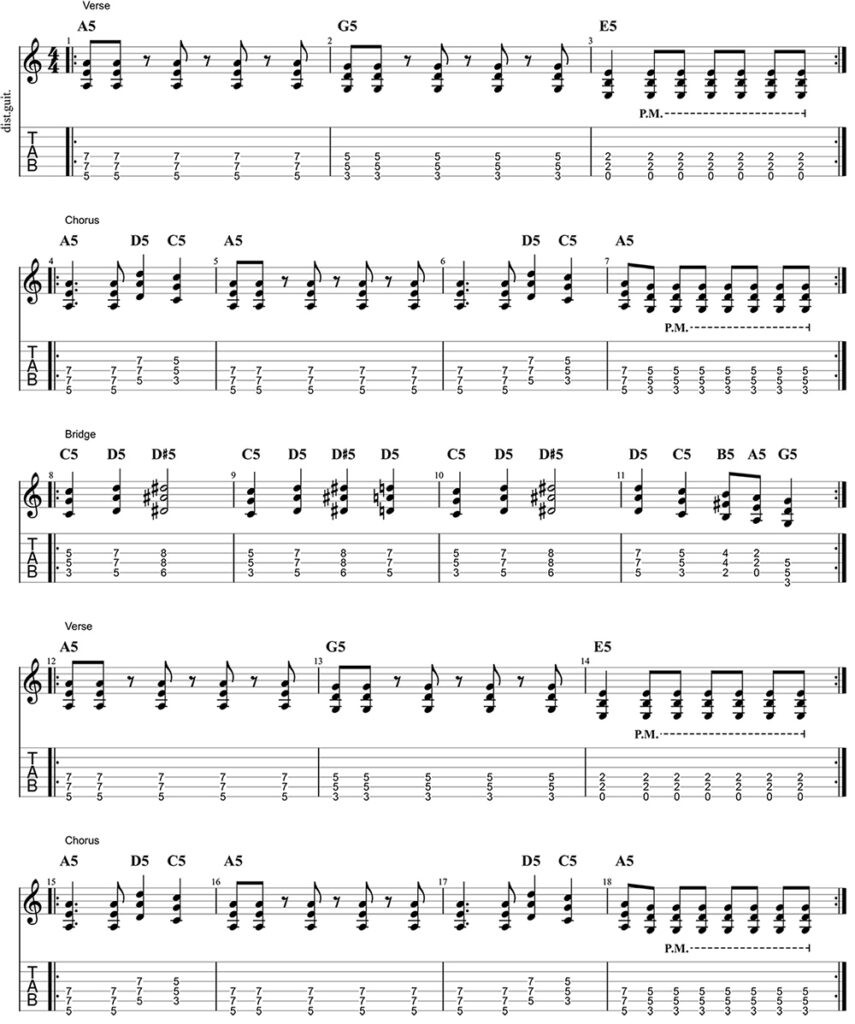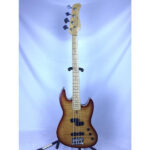Punk rock. Raw, energetic, and undeniably catchy. It’s a genre that throws pretense out the window and invites anyone with a guitar and something to say to join the party. For many guitarists, punk rock serves as the perfect entry point into songwriting. It’s often perceived as simpler than genres like heavy metal, blues, or jazz, making it less technically daunting and more creatively accessible.
Initially, as guitar skills improve, some might dismiss punk’s simplicity, believing there’s a ceiling to its musical depth. However, revisiting punk with a broader musical perspective reveals a powerful truth: simplicity is not a limitation, but a strength.
Punk music, despite its often straightforward structure, possesses an incredible ability to evoke and channel emotions. Music’s core purpose is to connect, express, and shift feelings, and punk achieves this with remarkable efficacy. Its directness and energy resonate with millions, proving that complexity isn’t a prerequisite for impactful music.
Furthermore, punk’s accessibility makes it an ideal “creative playground” for budding songwriters. Without the pressure of intricate guitar techniques, the focus shifts naturally to melody and creative expression. While punk might not be the genre to push technical guitar boundaries, it’s undeniably crucial for nurturing foundational songwriting skills. It teaches you to communicate powerfully and directly through music.
This guide provides a fundamental template for writing your own punk songs. While the steps may seem simple, the creative potential within these basic elements is virtually limitless. Dive in, and you’ll discover how to craft authentic and impactful punk anthems using your guitar.
(Note: This lesson assumes a basic understanding of punk guitar techniques. If you’re new to the genre, consider exploring beginner resources on how to play punk guitar first.)
Step 1: Choose Your Punk Guitar Chords
There’s no single “right” way to kickstart songwriting. Experimentation is key, and exploring various starting points only expands your creative toolkit. However, for punk, selecting chords first is a highly effective method.
Power chords reign supreme in punk rock. They are foundational, driving, and instantly recognizable. Technically, a power chord isn’t a complete chord, lacking the third interval that defines major or minor triads. However, with the rise of distortion in rock genres like punk, the traditional third interval could sound dissonant. Musicians adapted by simplifying chords to their root and fifth, and the power chord, though technically a double stop, became a staple chord voicing.
For our examples, we’ll use the classic punk power chord progression of A5, G5, and E5.
[Example of A5, G5, E5 power chords in tab]
Choose two, three, or four power chords that resonate well together. These will form the backbone of your initial riff, your song’s foundation. Don’t feel restricted to these initial choices; you can always introduce more chords later. Think of these first chords as your launching pad.
Experiment with different chord orders as well. At this stage, the sequence is less critical than finding chords that sound strong and punk-influenced when played together.
Step 2: Transform Chords into a Raw Punk Riff
While simply playing power chords in sequence can serve as a basic riff, you can inject much more energy and character into your Punk Guitar playing. Here are three key techniques to elevate your chords into authentic punk riffs, without adding new chords or changing their order:
- Rhythmic Subdivisions: Drive and Energy
In a basic chord progression, each chord might be strummed once per bar. To amp up the punk energy, increase the rhythmic density. Striking each chord multiple times within a bar, in a rhythmically compelling way, immediately creates a more driving and urgent feel.
The example below uses the same A5, G5, and E5 power chords, but now they are played with more rhythmic subdivisions, creating a more active and engaging riff.
 punk-song-2
punk-song-2
This is a step up, but we can push it further.
- Palm Muting: The Punk Rock Chug
Palm muting is a quintessential punk guitar technique. It involves resting the edge of your palm lightly on the strings near the bridge, creating a damped, percussive “chug-chug-chug” sound. Palm muting not only adds aggression but also introduces another rhythmic layer to your riffs.
The following example revisits the previous riff but incorporates palm muting on some of the chords. Listen to how this technique adds depth and rhythmic complexity.
[Example of riff with palm muting in tab]
- Rests: Silence Speaks Volumes
Rests, or intentional silences in music, are powerful tools for building tension and energy. Used across genres, rests are particularly effective in punk, especially in subgenres like Ska Punk, where they create a dynamic push-and-pull feel. Strategic silences can make the subsequent notes hit harder and create a more dynamic riff.
This example utilizes rhythmic subdivisions, palm muting, and rests to create a riff that is both energetic and varied.
 punk-song-4
punk-song-4
Experiment with these techniques using your chosen power chords. Loop your riff, play it repeatedly, and record it once you have something you like. This loop will be the foundation for the next steps.
Step 3: Craft a Catchy Vocal Melody and Lyrics
With your riff looping, the next step is to develop a vocal melody and lyrics that sit on top. Melody and lyric writing are skills honed through practice, but here’s a crucial insight:
Many novice punk bands, or those with limited appeal, often feature melodies that are surprisingly unmelodic. Their vocal lines might be confined to just one, two, or three notes, and rhythmically simplistic.
However, listen to iconic punk anthems, and you’ll discover a strong melodic sensibility. “I Fought The Law” by The Clash, “Ruby Soho” by Rancid, “Last Caress” by The Misfits, and “I Wanna Be Sedated” by The Ramones are prime examples of punk songs with undeniably catchy melodies.
While melodic preference is subjective, aiming for melodic interest is highly recommended for writing compelling punk songs. Practice writing lyrical phrases and melodies over your recorded riff. Refine and tweak until you find vocal lines that truly resonate with the riff’s energy and feel.
Actively analyze your favorite punk songs. Identify the melodies you find most appealing and try to pinpoint what makes them work. Then, apply these insights to your own melody writing. Pay attention to phrasing, rhythm, and note choices.
Step 4: Write a Complementary Second Riff
Now, it’s time to create a second riff that complements your initial one. To introduce musical variety, consider incorporating new chords in this second riff. However, it’s also effective to borrow elements from your first riff—rhythmic patterns, specific chord voicings—and either replicate them directly or use them as a starting point for variation.
This creates a sense of cohesion while still offering fresh musical ideas. Think of it as a conversation between riffs.
Here’s an example demonstrating a first riff and a second riff designed to fit with it. Notice how some chords are shared, and certain rhythmic figures are echoed, yet new chords and rhythmic variations give the second riff its own distinct character.
[Example of two riffs in tab, showing similarities and differences]
Step 5: Develop a Contrasting Melody and Lyrics (Verse and Chorus)
This step mirrors Step 3, but with a crucial distinction: you’re now thinking about song structure, specifically verse and chorus. Typically, a song features distinct melodies for the verse and chorus sections. It’s generally most effective to make one melody (usually the chorus) catchier, more impactful, and more memorable than the other (the verse). The chorus often features fewer words and more repetition to enhance memorability.
Consider Rancid’s “Ruby Soho” again. The verses, with lyrics like “Echoes of Reggae…”, have a relatively less melodic, almost spoken-word feel, creating anticipation. This contrasts sharply with the explosively melodic chorus: “Destination Unknown, Ruby, Ruby, Ruby, Ruby, Soho.”
This contrast isn’t accidental. The less melodic verse builds anticipation and makes the melodic release of the chorus even more powerful. Think about creating this kind of dynamic contrast in your own song structure.
Step 6: Structure Your Punk Song
By this point, you should have enough musical material – riffs and melodic ideas – to start structuring your song. You can keep it simple with a verse-chorus-verse-chor structure. In that case, refine what you have until it naturally flows into this form.
If you want to explore more dynamic structures, consider adding these elements:
- The Bridge: A Moment of Contrast
A bridge is a section designed to provide contrast and connect different parts of your song. To create an effective bridge (which will often be a new riff), aim for something that musically contrasts with the verse and chorus. Using different chords is a common technique to achieve this contrast. The bridge offers a change of pace and prevents the song from becoming too repetitive.
The song structure example below shows a verse-chorus-bridge-verse-chor arrangement.
 punk-song-6
punk-song-6
Notice how the bridge provides a distinct musical departure before returning to the familiar verse and chorus.
- Guitar Solos: Optional Punk Flair
Guitar solos are not mandatory in punk, but bands like The Clash, Rancid, and The Sex Pistols incorporated short, energetic solos into some of their songs. If you want to add a solo, choose one of your song’s riffs as the backing and improvise over it. Keep the solo concise and in the spirit of punk – raw and energetic, not overly technical or lengthy.
[Example of a short punk guitar solo tabbed over the first riff]
- Guitar Licks: Melodic Embellishments
Guitar licks are like miniature solos – very short melodic phrases. Unlike solos that are focal points, licks are subtle melodic decorations woven into the song. Use them sparingly to add brief moments of melodic interest in transitions or at the end of phrases.
[Example of guitar licks in tab]
- Intro: Setting the Stage
Many punk songs begin with a short intro riff before the main song sections kick in. “Ruby Soho” is, again, a great example. An intro riff sets the tone, grabs the listener’s attention, and creates anticipation for the song to unfold.
Step 7: Bring in the Drums (and the Band!)
Once you’ve refined the song structure and musical elements to your satisfaction, the core songwriting is largely complete. The next step is to consider the other instruments, particularly drums.
While you don’t need to write out every part, think about how drums and bass will enhance your guitar riffs and melodies. The bassist will create a bass line that complements the guitar chords, and the drummer will establish a punk beat that drives the song’s energy.
Unless you’re singing yourself, the vocalist is another key consideration. When presenting your melody to a singer, be open to collaboration. Singers often have unique phrasing instincts. If they alter the melody, evaluate if their interpretation improves it. Sometimes, a singer’s vocal phrasing can enhance the melody in unexpected ways. If not, gently guide them back to your intended melodic shape.
Conclusion: Write, Write, and Write Some More Punk Songs
The beauty of punk is its accessibility. Once you grasp the basic principles, writing a punk song becomes surprisingly straightforward. However, just like any genre, there are great punk songs and less effective ones.
The key to becoming a proficient punk songwriter is prolific writing. Write as many songs as you can. Many will end up discarded – even seasoned songwriters have a high “trash-to-treasure” ratio. Embrace the process of writing and discarding.
Each completed song, regardless of its final destination (released or trashed), provides a valuable lesson. The songs you keep teach you what works, what resonates. The discarded songs reveal what doesn’t, helping you refine your songwriting instincts. So, keep writing, keep experimenting, and keep rocking!

